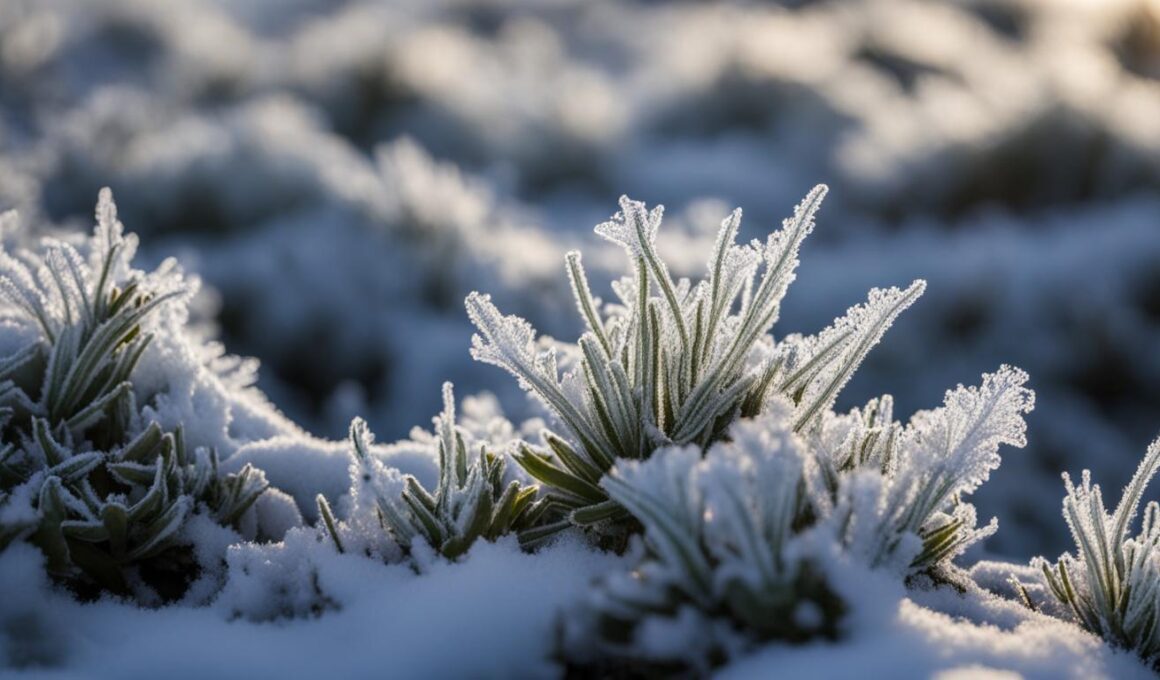Protecting your plants from the cold winter months is essential, and frost cloth for plants can be your best friend in freeze protection. Whether you have delicate flowers or valuable crops, a frost cloth can safeguard your greenery from icy temperatures and frost. By using plant covers for winter, you can ensure the health and well-being of your plants, even in the harshest of climates.
Frost cloth is specifically designed to shield your plants from the cold, wind, frost, hail, and insects. Made with durable and corrosion-resistant materials, it provides reliable and long-lasting protection. While keeping the elements at bay, frost cloth still allows light, moisture, and air to penetrate, creating an optimal environment for your plants to thrive.
One popular option in the market is the Agfabric 1.2 oz. 10 ft. x 25 ft. frost cloth for plants row cover frost blanket. This sizeable frost cloth offers ample coverage for your garden, ensuring that all your plants receive the protection they need.
Installing and removing frost cloths is a breeze, making them a convenient solution for plant owners. With the right frost cloth, you can enjoy peace of mind knowing that your plants are safe and sound, even when the temperatures drop.
Choosing the Best Frost Cloth for Plants
When it comes to selecting the best frost cloth for your plants, there are a few important factors to consider. One of the most crucial aspects is the material of the frost cloth. Polypropylene fabric is highly recommended for its exceptional frost protection capabilities. It not only dries quickly but is also breathable and lightweight, making it ideal for safeguarding delicate crops.
There are different types of frost blankets available in varying weights to suit different needs. For longer-term applications or light frosts, you can choose a lightweight frost blanket weighing around 1.5 oz. It provides adequate protection while allowing sufficient light transmission to nurture your plants.
If you need more substantial protection without compromising light penetration, a mid-weight frost blanket weighing approximately 2.5 oz is a great choice. It strikes a balance between frost protection and sunlight exposure, ensuring your plants thrive even in colder climates.
For those who reside in areas with extremely cold climates, opting for a heavy-duty frost blanket with a weight of around 4.0 oz is highly recommended. This robust frost cloth offers extra insulation and protection against severe frost, helping your plants withstand even the harshest winter conditions.
Regardless of the weight you choose, ensure that the frost blanket covers your plants entirely, including the ground. This will help retain heat from the soil and create a microclimate that keeps your plants warmer during chilly nights. Investing in the best frost cloth for your plants will provide the necessary protection to keep them healthy and thriving.
Now that you have a better understanding of the different types of frost blankets and their benefits, you can make an informed decision based on your specific needs and the climate you live in. The right frost cloth will ensure the well-being of your plants and help them flourish, even in the face of freezing temperatures.
How to Use Frost Cloth for Plants
Installing frost blankets is a simple process that helps protect your plants from frost damage. Whether you’re growing row crops or tending to individual plants, there are a few key steps to follow when using frost cloth:
- Placement: You can place the frost blankets directly on your plants or use low-tunnel hoops for row crops. When using the cloth without hoops, it’s called a floating row cover. Ensure that the entire plant and surrounding area are covered.
- Anchoring: To keep the frost cloth securely in place, use landscape fabric pins, rocks, or sandbags to anchor the edges. This prevents wind from blowing the cover off and exposing your plants to frost.
- Early installation: Install the frost blanket before the frost sets in to provide maximum protection for your plants. Don’t wait until the last minute, as cold weather can sneak up unexpectedly.
- Daytime removal: When the temperature rises above 50 degrees during the day, it’s important to remove the frost cloth. Leaving it on can cause the plants to overheat and potentially suffer damage.
- Proper storage: After removing the frost cloth, lightly rinse it with cool water if it becomes soiled. Let it air dry completely before folding and storing it in a dry place. This helps maintain the integrity of the fabric for future use.
- Snowfall precautions: If heavy snowfall is in the forecast, it’s best to remove the frost cloth or shake off any accumulated snow. The weight of the snow can damage the plants or cause the fabric to tear.
Using frost cloth to protect your plants from frost is an effective way to extend the growing season and ensure the health and vitality of your greenery. By following these simple steps for installation, removal, and storage, you can successfully safeguard your plants from cold temperatures and enjoy a thriving garden.
Conclusion
Frost cloth for plants is an indispensable tool for protecting your garden during the winter months. It acts as a reliable barrier, shielding your plants from cold temperatures, wind, and frost, ensuring their health and vitality. With a wide range of options available, including lightweight, mid-weight, and heavy-duty frost blankets, you can select the perfect one to meet your specific needs.
Proper installation and removal of the frost cloth are crucial for maintaining optimal plant health. It is important to avoid overheating your plants by removing the cloth during warm days when the temperature rises above 50 degrees. By following these simple steps, you can extend the growing season, protect your plants from frost damage, and ensure their successful growth and development even in cold climates.
Investing in frost protection for plants not only helps safeguard your garden, but also provides peace of mind during the winter season. With the right choice of winter plant covers, you can create a nurturing environment for your plants, ensuring their survival and allowing them to thrive. So, don’t forget to include frost cloth in your plant winter care routine and give your garden the best possible protection against the harsh winter conditions.
Is Using Frost Cloth Effective in Protecting Ferns During Winter?
Using frost cloth can be effective in helping ferns survive winter. The protective fabric helps to insulate the plants and shield them from harsh weather conditions. By covering the ferns with frost cloth during the colder months, you can ensure their survival and promote healthy growth in the spring.
Source Links
- https://www.greenhousemegastore.com/collections/cold-frost-protection
- https://www.homedepot.com/p/Agfabric-1-2-oz-10-ft-x-25-ft-Frost-Cloth-for-Plants-Row-Cover-Frost-Blanket-for-Freeze-Protection-RC1210025/315590208
- https://www.bootstrapfarmer.com/blogs/building-a-greenhouse/frost-blanket-how-to-use-it-and-when










